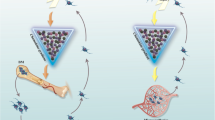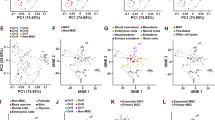Abstract
Here we compared MSCs isolated from bone marrow (BMSC) and peripheral blood at 2 days after intravenous substance P (SP) injection (MSCSP) to define specific roles of circulating MSCs in tissue repair process. The mass analysis of changed genes over and under log2 fold showed 97% of genes were identical in these two groups. We found MSCSP increased the molecular signatures related to homing and engraftment (tetraspanin 8, tetraspanin 12), extracellular matrix (ECM) (collagen type IV α1, nidogen 2, laminin-α5, basement membrane components; collagen type XII α1, collagen XV α1, ECM components linking basement membrane to stroma), transmigration (ICAM-1, P-selectin, endothelin), motility (Rho GTPase activating protein 8, myosin heavy chain 10 and 11, troponin C type 1 and 2), transdifferentiation potential (keratin 19, CMTM 8), immunity (IL-1α, IL-33, IL-1R type 1), and angiogenesis (endothelin1, VEGF-C, IL-33, laminin-α5) according to functional classification of the 3 % of changed genes. Functional differences were also shown in MSCSP in regulation of viability of immune cells, Jurkat T cells and U937 monocytes. In addition, a-smooth muscle actin (α-SMA) significantly increased in MSCSP compared with BMSC, demonstrating committed differentiation to myofibroblast participated in tissue repair. However, intrinsic differentiation potential to mesenchymal tissues, adipogenesis and osteogenesis, was not altered in MSCSP. From the molecular and cellular phenotyping of MSCSP, circulating MSCSP seems to be a distinct population mobilized from heterogenous BMSC with well adapted for the participation in tissue repair process by enhancing homing, engraftment, migration, and angiogenesis with multipotent differentiation potential to either myofibroblasts or epithelial-like cells.
Similar content being viewed by others
References
P Bianco, PG Robey, PJ Simmons, Mesenchymal stem cells: revisiting history, concepts, and assays, Cell Stem Cell, 2, 313 (2008).
JA Ankrum, JF Ong, JM Karp, Mesenchymal stem cells: immune evasive, not immune privileged, Nat Biotechnol, 32, 252 (2014).
ME Bernardo, WE Fibbe, Mesenchymal stromal cells: sensors and switchers of inflammation, Cell Stem Cell, 13, 392 (2013).
Y Shi, J Su, AI Roberts, et al., How mesenchymal stem cells interact with tissue immune responses, Trends Immunol, 33, 136 (2012).
S Ma, N Xie, W Li, et al., Immunobiology of mesenchymal stem cells, Cell Death Differ, 21, 216 (2014).
E Chung, Y Son, Crosstalk between mesenchymal stem cells and macrophages in tissue repair, Tissue Eng Regen Med, 11, 431 (2014).
HS Hong, J Lee, E Lee, et al., A new role of substance P as an injury-inducible messenger for mobilization of CD29(+) stromal-like cells, Nat Med, 15, 425 (2009).
HS Hong, Y Kim do, KJ Yoon, et al., A new paradigm for stem cell therapy: substance-P as a stem cell-stimulating agent, Arch Pharm Res, 34, 2003 (2011).
W Ahn, HS Hong, M Zhang, et al., Induction of mesenchymal to epithelial transition of circulating mesenchymal stem cells by conditioned medium of injured cornea, Tissue Eng Regen Med, 10, 86 (2013).
KH Larsen, CM Frederiksen, JS Burns, et al., Identifying a molecular phenotype for bone marrow stromal cells with in vivo bone-forming capacity, J Bone Miner Res, 25, 796 (2010).
E Chung, W Ahn, Y Son, CXCL5 is abundant in the wound fluid at the late phase of wound healing, possibly promoting migration of mesenchymal stem cells and vascular tube formation, Tissue Eng Regen Med, 11, 1 (2014).
W Cho, S Nam, J Jang, et al., Comparative evaluation of differentiation potentials of various stem cells from mesenchymal tissue origin, Tissue Eng Regen Med, 7, 355 (2010).
JY Yi, YJ Jung, SS Choi, et al., Autophagy-mediated antitumoral activity of imiquimod in Caco-2 cells, Biochem Biophys Res Commun, 386, 455 (2009).
A Sohni, CM Verfaillie, Mesenchymal stem cells migration homing and tracking, Stem Cells Int, 2013, 130763 (2013).
WJ Rombouts, RE Ploemacher, Primary murine MSC show highly efficient homing to the bone marrow but lose homing ability following culture, Lekemia, 17, 160 (2003)
M Zoller, Tetraspanins: push and pull in suppressing and promoting metastasis, Nat Rev Cancer, 9, 40 (2009).
AM Roccaro, A Sacco, P Maiso, et al., BM mesenchymal stromal cell-derived exosomes facilitate multiple myeloma progression, J Clin Invest, 123, 1542 (2013).
I Nazarenko, S Rana, A Baumann, et al., Cell surface tetraspanin Tspan8 contributes to molecular pathways of exosome-induced endothelial cell activation, Cancer Res, 70, 1668 (2010).
V Paunescu, E Deak, D Herman, et al., In vitro differentiation of human mesenchymal stem cells to epithelial lineage, J Cell Mol Med, 11, 502 (2007).
W Zhang, MC Mendoza, X Pei, et al., Down-regulation of CMTM8 induces epithelial-to-mesenchymal transition-like changes via c-MET/extracellular signal-regulated kinase (ERK) signaling, J Biol Chem, 287, 11850 (2012).
R Hallmann, N Horn, M Selg, et al., Expression and function of laminins in the embryonic and mature vasculature, Physiol Rev, 85, 979 (2005).
C Spenle, P Simon-Assmann, G Orend, et al., Laminin alpha5 guides tissue patterning and organogenesis, Cell Adh Migr, 7, 90 (2013).
K Ley, C Laudanna, MI Cybulsky, et al., Getting to the site of inflammation: the leukocyte adhesion cascade updated, Nat Rev Immunol, 7, 678 (2007).
S Hanna, M El-Sibai, Signaling networks of Rho GTPases in cell motility, Cell Signal, 25, 1955 (2013).
C Garlanda, CA Dinarello, A Mantovani, The interleukin-1 family: back to the future, Immunity, 39, 1003 (2013).
FY Liew, NI Pitman, IB McInnes, Disease-associated functions of IL-33: the new kid in the IL-1 family, Nat Rev Immunol, 10, 103 (2010).
LR Lopetuso, F Scaldaferri, TT Pizarro, Emerging role of the interleukin (IL)-33/ST2 axis in gut mucosal wound healing and fibrosis, Fibrogenesis Tissue Repair, 5, 18 (2012).
GY Chen, J Tang, P Zheng, et al., CD24 and Siglec-10 selectively repress tissue damage-induced immune responses, Science, 323, 1722 (2009).
KE Johnson, TA Wilgus, Vascular Endothelial Growth Factor and Angiogenesis in the Regulation of Cutaneous Wound Repair, Adv Wound Care (New Rochelle), 3, 647 (2014).
YS Choi, HJ Choi, JK Min, et al., Interleukin-33 induces angiogenesis and vascular permeability through ST2/TRAF6-mediated endothelial nitric oxide production, Blood, 114, 3117 (2009).
Author information
Authors and Affiliations
Corresponding authors
Rights and permissions
About this article
Cite this article
Ahn, W., Jang, J., Lim, J.E. et al. Identifying a molecular and cellular phenotype of mesenchymal stem cells mobilized from substance P in the peripheral blood. Tissue Eng Regen Med 12, 128–142 (2015). https://doi.org/10.1007/s13770-015-0105-4
Received:
Revised:
Accepted:
Published:
Issue Date:
DOI: https://doi.org/10.1007/s13770-015-0105-4




